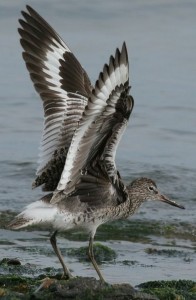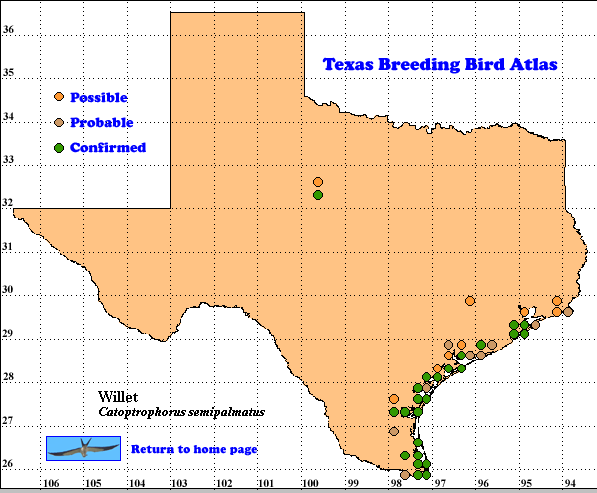The Willet is a large, heavy-bodied member of the sandpiper family Scolopacidae (Am. Ornithol. Union 1998) with generally drab gray-brown markings. Plumages of both sexes are similar and there are only slight differences in coloration between breeding and winter plumages. The Willet’s bill is relatively long and heavy, and is used to probe in soft sediments for invertebrate prey. A distinctive call and bold black and white wing markings distinguish it from similarly sized sandpipers such as the Greater Yellowlegs (Tringa melamoleuca) and Marbled Godwit (Limosa fedoa).
As year round residents of Texas, Willets are commonly observed feeding on mud or sand flats in bayous, bays and estuaries. On the Texas coast in winter, the Willet may be observed feeding on beaches, walking along the water’s edge, sometimes wading up to its belly in the surf. The Willet walks along with a head bobbing motion, probing in the sediment for small crustaceans and insects. When disturbed, it rises with a loud distinctive call that typically alarms all other birds nearby.
Widespread and common along the Gulf of Mexico coast year round, the Willet is the only the sandpiper known to breed with any frequency or abundance in Texas (Oberholser 1974).
DISTRIBUTION: Willet distribution is directly related to the distribution of wetlands in North America. There are two races in the United States, the western and eastern races. Birds found in Texas generally belong to the eastern race (Bent 1929). Willets are wetland dependent birds and their distribution is primarily coastal in the Southeastern United States. In northern areas, Willets nest along the edges of rivers, streams and lakes. In southern states, they nest semi-colonially (Ehrlich et al. 1988) in coastal salt marshes and dunes. The TBBA shows that Willets have been observed breeding in most of the coastal counties of Texas. Although nesting is restricted to salt marshes and beach dunes, they may be observed foraging year round on beaches of the Gulf of Mexico and along shorelines and mudflats of coastal bays. Audubon Christmas Bird Counts show an average count of 3 to 30 birds in coastal Texas with fewer observed on inland rivers and bays. (American Birds).
SEASONAL OCCURRENCE: Willets are present in Texas year round. However, some belong to a migratory population which is present during the winter months only. Willets are primarily found on the coast in Texas as with the rest of the southeastern United States. In winter, they are often observed feeding on sandy beaches, mudflats, and low seagrass flats (Oberholser 1974, Lowther et al. 2001) where they may be accompanied by other species of sandpipers.
During the breeding season, Willets are observed along salt marsh vegetation edges where they are nesting, as well as foraging in the surf at beaches. The breeding season extends from mid-April (first eggs) through early June. The earliest egg laying date reported by the TBBA is April 21, however, Bent (1929) reports observing eggs as early as April 3. Willet young are precocial at hatching and able to follow the mother to rearing areas (Howe 1982) where they remain until fledging occurs at 2-3 weeks. Spring migration dates are between late March and mid-May; fall migration dates are from mid-July to mid-September (Lockwood and Freeman 2004).
BREEDING HABITAT: In Texas, the Willet breeds in salt marshes in bay systems and along the Gulf of Mexico coast. Breeding pairs inhabit salt marshes composed of Spartina alterniflora (smooth cordgrass) as well as sand dunes with clumps of beach grass (Panicum amarum) or sea oats (Uniola paniculata; Oberholser 1974). Nests are built as a shallow depression on a wet beach or flat and are often concealed by thick vegetation. Four to five olive colored eggs with bold irregular brown or olive splotches (Bent, 1929, Ehrlich et al. 1988) are laid and grasses are bent over the nest to form a hollow which is lined with vegetation. The female typically chooses the nest site and nest construction is completed during laying (Ehrlich et al. 1988). Nesting begins in late April and extends into early June. Feeding territories are established and used by nesting pairs (Howe 1982) and both members of the pair defend this territory both visually and vocally (Sordahl 1979, Howe 1974). Pairs may also share inter-tidal mud flats used for loafing and bathing (Howe 1982). A separate rearing territory is used for raising young birds and is usually different from the adult feeding territory (Howe 1982).
STATUS: The Breeding Bird Survey data for Willet in Texas are based on only 7 routes and do not provide a biologically meaningful trend. Breeding Bird Survey data for North America indicate a slight decrease (-0.7% per year) in Willet populations overall for the period 1966-2005 (Sauer et al. 2005). Lockwood and Freeman (2004) consider Willet a common to abundant resident along the Texas coast.
Text by Stefani Melvin (ca. 1995, posted with updates 2006)
Literature cited.
American Ornithologists’ Union. 1998. Checklist of North American birds, 7th ed. Am, Ornithol. Union, Washington, DC.
Bent, A. C. 1929. Life histories of North American shore birds. Pt. 2: U. S. Nat. Mus. Bull. 146.
Ehrlich, P. R., D. S. Dobkin, and D. Wheye. 1988. The birder’s handbook. Simon & Schuster, New York.
Howe, M. A. 1974. Observations on the terrestrial wing displays of breeding Willets. Wilson Bull. 86: 286-288.
Howe, M. A. 1982. Social organization in a nesting population of Eastern Willets (Catoptrophorus semipalmatus). Auk 99 :88-102.
Lockwood, M. W. and B. Freeman. 2004. The TOS handbook of Texas birds. Texas A&M University Press, College Station
Lowrher, P. E., H. D. Douglas III and C. L. Gratto-Trevor. 2001. Willet (Catoptrophorus semipalmatus). InThe Birds of North America, No. 579 (A. Poole and F. Gill, eds.). The Birds of North America, Inc.,
Oberholser, H. C. 1974. The bird life of Texas, University of Texas Press, Austin.
Sauer, J. R., J. E. Hines, and J. Fallon. 2005. The North American Breeding Bird Survey, results and analysis 1966-2005. Version 6.2 2006. USGS Patuxent Wildlife Research Center, Laurel MD < http://www.mbr-pwrc.usgs.gov/bbs>
Sordahl, T. A. 1979. Vocalizations and behavior of the Willet. Wilson Bull.91: 551-574.

